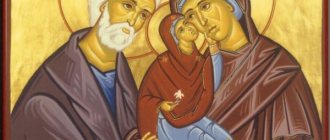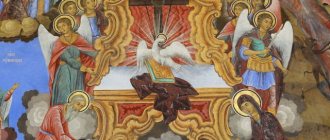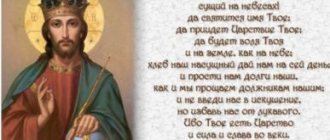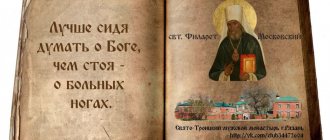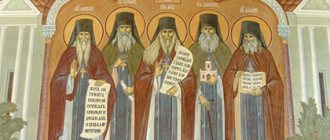Text of the Creed
There is no letter “е” in the Church Slavonic language, therefore all e must be read as “e”.
Download in Microsoft Word format
| 1st. I believe in one God, the Father, Almighty, Creator of heaven and earth, visible to all and invisible. | I believe in the only God the Father, Almighty, Creator of heaven and earth, everything visible and invisible. |
| 2nd. And in one Lord Jesus Christ, the Son of God, the only begotten, who was born of the Father before all ages; Light from Light, true God from true God, begotten, uncreated, consubstantial with the Father, by whom all things were; | (I believe) in the only Lord Jesus Christ, the Son of God, the only one begotten of the Father in eternity; Light from Light, true God from true God, begotten, not created, one being with the Father, through whom all things were created; |
| 3rd. For our sake, man and our salvation came down from heaven, and became incarnate from the Holy Spirit and the Virgin Mary, and became human; | For us people and for our salvation, He came down from heaven, took flesh from the Holy Spirit and the Virgin Mary, and became human; |
| 4th. Crucified for us under Pontius Pilate, and suffered and was buried; | Crucified for us under Pontius Pilate, suffered and buried; |
| 5th. And he rose again on the third day, according to the Scriptures; | And rose again on the third day, according to the Scriptures (prophetic). |
| 6th. And ascended into heaven, and sits at the right hand of the Father; | And ascended into heaven and sat at the right hand of the Father; |
| 7th. And again the one who is to come will judge with glory the living and the dead, His Kingdom will have no end. | And again He will come with glory to judge the living and the dead, whose kingdom will have no end. |
| 8th. And in the Holy Spirit, the Lord, the Life-Giving One, who proceeds from the Father, who is with the Father and the Son, worshiped and glorified, who spoke the prophets. | (I believe) also in the Holy Spirit, the Lord, the giver of life, who proceeds from the Father, worshiped and glorified equally with the Father and the Son, who spoke through the prophets. |
| 9th. Into the One, Holy, Catholic and Apostolic Church. | (I believe) in the One and Only, Holy, Catholic (Ecumenical) and Apostolic Church. |
| 10th. I confess one Baptism for the remission of sins. | I confess one Baptism for the remission of sins. |
| 11th. I hope for the resurrection of the dead. | I look forward to the resurrection of the dead. |
| 12th. And the life of the next century. Amen. | And the life of the next century. Truly so. |
All uses of the word "one" in the Slavic Creed correspond to the various forms of the word eis in the Greek text. It means "one, one, one" with an emphasis on singularity.
I believe - I believe, I am convinced; Only Begotten - the only one before all ages - before all time, from eternity; consubstantial with the Father - having the same essence (nature, nature) with (God) the Father; By Him all things were, and by Him, that is, the Son of God, all things were created; incarnate - having taken becoming human - becoming resurrected - revived: according to Scripture - in accordance ascended - ascended; right hand - on the right side of God the Father, the Word sitting
, that is, sitting on the right side (this phrase should be understood in the sense that Jesus Christ has the same power and glory with God the Father);
paki - again, for the second time; the dead - the dead who will then be resurrected; There will be no end to His Kingdom - after the judgment, His Kingdom will come endlessly; Life-giving - life- giving worshiped and glorified - the Holy Spirit should be worshiped and glorified equally with the Father and the Son, that is, the Holy Spirit is equal to God the Father and God the Son; The prophets spoke - the Holy Spirit spoke through the prophets; Conciliar - consonant, unanimous, embracing people from all over the universe; I confess - I openly confess in word and deed; tea - I'm waiting; And the life of the next century - eternal life will come after the general judgment.
***
Akathists
The site contains a brief overview of the “Creed”. In the future, the site will be updated with interpretations of akathists and video clips will be made on these akathists.
When reading the akathist at home, it is advisable to take a blessing from the priest. You can read the akathist at a time convenient for you. The reading of the initial prayers begins as in morning and evening prayers, the end of the reading of the akathist also ends with prayers as in morning and evening prayers.
Akathist is a hymn, glorification of God, the Holy One. As a rule, reading is done standing. But, if you are weak, sick, or cannot stand in front of the icon, you can, for example, listen to the akathist at lunchtime at work. Then, of course, you will not be able to strictly follow all the rules.
What matters is that your heart truly desires to glorify the Lord. Therefore, as the Apostle Paul said: “Pray without ceasing” (1 Thess. 5:17). Nothing should be an obstacle to prayer.
When did the Creed appear?
Since apostolic times, Christians have used so-called “articles of faith” to remind themselves of the basic truths of the Christian faith. The ancient church had several short creeds. In the 4th century, when false teachings about God the Son and the Holy Spirit appeared, the need arose to supplement and clarify the previous symbols.
At the First Ecumenical Council the first seven members of the Symbol were formulated, at the Second – the next five. The First Ecumenical Council took place in the city of Nicaea in 325 after the Nativity of Christ to establish the apostolic teaching about the Son of God against the incorrect teaching of Arius, who believed that the Son of God was created by God the Father and therefore is not the true God. The Second Ecumenical Council took place in Constantinople (Constantinople) in 381 to confirm the apostolic teaching about the Holy Spirit against the false teaching of Macedonius, who rejected the Divine dignity of the Holy Spirit. For the two cities in which these Ecumenical Councils took place, the Creed is called Nicene-Constantinopolitan.
Ecumenical councils and local churches
Historically, different Christian churches have different attitudes towards Ecumenical Councils and have their own opinions about their number. Based on the main features of the Ecumenical Council, namely “recognition of the Ecumenical Council by all local churches”
and
“the unanimous expression on it of the creed, which all local churches adhered to and adhere to everywhere and always”
, the indisputable status of the Ecumenical Council, from among the so-called, only the first two have, since they are recognized as Ecumenical by all local churches and their decisions do not cause objections to anyone .
Two Ecumenical Councils are recognized by the Assyrian Church of the East, which was initially isolated from the process of development of dogmas in the Roman Empire due to its isolation in Zoroastrian Persia. Due to the irrelevance of the councils held in Byzantium for the ACV, their decisions were made by it much later. Thus, the Council of Nicea in 325 was adopted at the local council of the ACV under the chairmanship of the Catholicos of Armenia Mar Akak in 410, that is, almost a century later, shortly before the III Council. And the Council of Constantinople of 381 was adopted in 554 at the Council of Mar Joseph, that is, almost two centuries later, when not only the III Council of Ephesus in 431, which condemned Nestorius, had already been held, but also the Council of Chalcedon in 451 and the II Council of Constantinople in 553, at in which the canonical unity of the ACV with the Church of the West (current Orthodox and Catholics) was destroyed. At present, Eucharistic unity is also impossible, if only because the ACV teaching on the Eucharist, accepted by Protestants, makes it absolutely non-Orthodox, despite the fact that the Orthodox and the Church of the East did not anathematize each other. All this indirectly indicates that the opinion of the Church of the East about the number and importance of Ecumenical Councils: in its opinion, the III and subsequent councils were only local councils of the Church of the West, although some of their decisions (for example, the condemnation of Platonism and Origenism at the II Council of Constantinople) East accepted - cannot serve as an undoubted criterion for confirming the status of subsequent councils for the remaining churches.
The Miaphysite Ancient Eastern Churches (Oriental Old Orthodox Churches) had a different attitude towards the Ecumenical Councils, which actively participated in Christian dogmatic creation, both taking part in the councils and expressing their attitude towards them after and often taking individual decisions. The ancient Eastern Orthodox churches of the times of Christological disputes represented the overwhelming majority of regional local churches (against Rome alone and the wavering Constantinople, all the Eastern patriarchates in the empire and beyond, which was presented as “national separatism”), and therefore rejection of the decisions of Chalcedon and subsequent cathedrals by the Ancient Eastern Miaphysite churches, deprived, in their opinion, these cathedrals of the main features of Ecumenical Councils and any cathedrals in general. Accordingly, only three Ecumenical Councils are recognized by the Ancient Eastern Miaphysite Churches; they refuse to recognize the remaining councils even as local ones.
As for the Orthodox churches of the Byzantine tradition, they all recognize the seven Ecumenical Councils held before the Great Schism. The issue of non-recognition of councils, starting from Chalcedon, by the Ecumenical Councils and in general councils by the Miaphysite churches by the Church of Byzantium was resolved by the fact that the Universe (Ecumene) in the minds of the Greeks and Latins was associated with the Roman Empire, and the Ecumenical Church itself - with the patriarchates recognizing the spiritual primacy of the Roman bishops and the administrative power over the church of emperors. The Ancient Eastern churches, which did not take such logic into account, were declared anti-Chalcedonian imperial churches that “fell away from the Ecumenical Church,” and their opinion on the number and status of councils was not taken into account since then, which is why all subsequent councils were considered Ecumenical.
With the gradual weakening of the political influence of Byzantium, especially after the division of the churches - the two halves of the once united Church of the Roman Empire in 1054, the Western Roman Church, correlating catholicity (as an indispensable sign of one indivisible Universal Church) only with the episcopal see of Rome and counting all other local churches “those who fell away from unity with the See of Peter,” began to call their councils Ecumenical, accordingly assigning serial numbers to them. Thus, to date, from the point of view of the Roman Catholic Church, 21 Ecumenical Councils have taken place.
At what services is the reading or singing of the Creed performed?
The Symbol of Faith is pronounced by those receiving Baptism (“catechumens”) during the Sacrament of Baptism. At the baptism of an infant, the Creed is pronounced by the recipients. In addition, the Symbol of Faith is collectively sung by believers in church during the Liturgy, read daily as part of the morning prayer rule, and is part of the Midnight Office, Fine Compline and Great Compline.
When did the name “Creed” appear?
The phrase “Creed” was not immediately used by the Church. In the first centuries of Christianity, instead of the “Creed” they said: “Statement of Faith” or simply “Faith”. For example, the Apostolic Faith of the Church of Jerusalem, the Universal Faith of the Church of Antioch, and so on. We first find the phrase “Creed” in St. St., who lived in the 4th century. Ambrose of Milan, in his Letter (XLII) to Pope Sirius I.
Used materials
- Meyendorff, Paul, Russia, Ritual & Reform.
The Litrugical Reforms of Nikon in the 17th Century , Crestwood, NY: St. Vladimir's Seminary Press, 1991, 177-179, 208-209.
[1] The pre-reform text and description of the correction are given by Meyendorff, Paul, Russia, Ritual & Reform. The Litrugical Reforms of Nikon in the 17th Century
, Crestwood, NY: St.
Vladimir's Seminary Press, 1991, 177-179, 208-209. In turn, Meendorff retells the study of Gesen A., History of the Slavic translation of the creeds
, St. Petersburg, 1884, 57-67.
[2] Here and below the Russian text is given from: prot. Peter Lebedev. A guide to understanding Orthodox worship. St. Petersburg, 1898, pp. 10-11.
Does the Bible contain any parallels to the Creed?
The prototype of the Creed can be found in the First Letter to the Corinthians of the Holy Apostle Paul: “For I taught you from the beginning what I also received, that is, that Christ died for our sins according to the Scriptures, and that He was buried, and that He rose again the third day, according to the Scripture, and that he appeared to Cephas, then to the twelve; then he appeared to more than five hundred brethren at one time, most of whom are still alive, and some have died; then he appeared to James, and also to all the Apostles” (1 Cor. 15:3-7).
